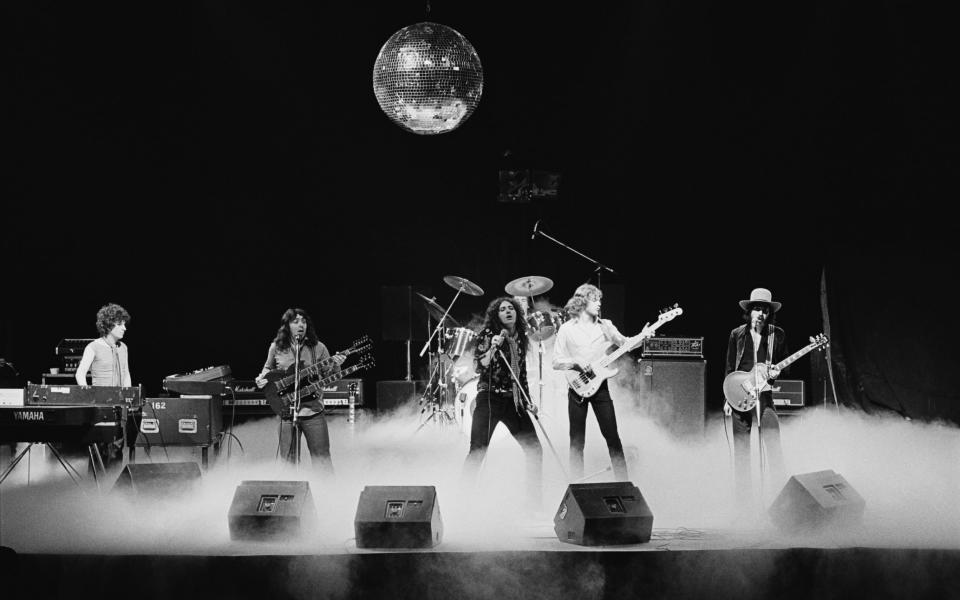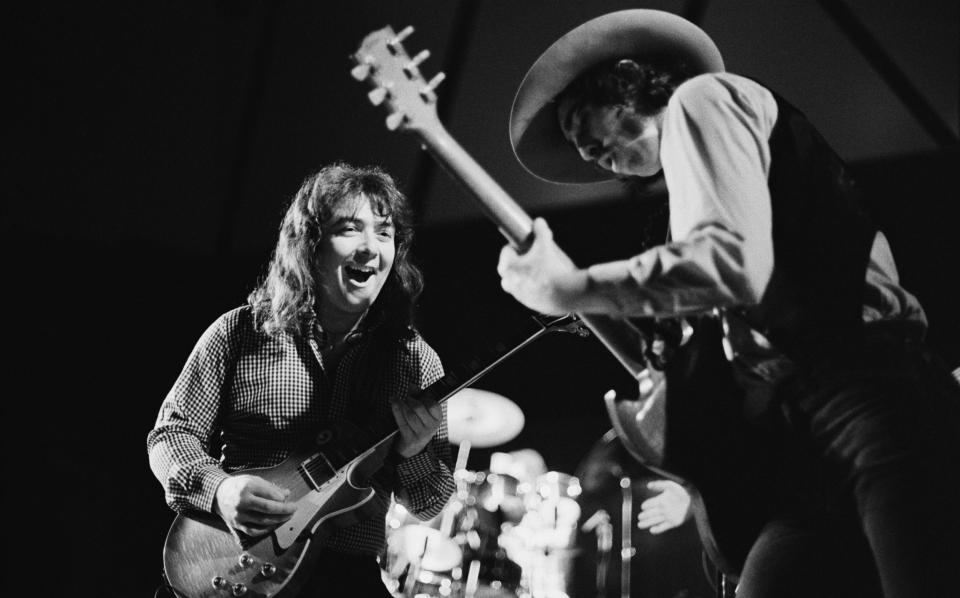Whitesnake’s Bernie Marsden on snubbing Paul McCartney and his final moments with Peter Green

Rock stars like to tell stories about their showbiz encounters. About how they once jammed with George Harrison or hung out with Roger Moore on a Bond set or played guitar with Chic. But few musicians can claim to have as rich a stash of rock ‘n’ roll stories as Bernie Marsden. You may have never heard of him. But not only did he do all of the above, he was also friends with B.B. King, almost joined Paul McCartney’s Wings and was probably the last person to play guitar with Fleetwood Mac founder Peter Green before he died last summer.
Oh, Marsden also wrote one of the most successful power ballads of all time. As the guitar player in the original line-up of Whitesnake, he co-wrote Here I Go Again, a song that still gets played 500 times a day on US radio almost 40 years after it was penned. It’s no exaggeration to say that the 70 year-old is rock’s version of Logan Mountstuart, the fictional writer whose experiences spanned the defining episodes of the 20th century in William Boyd’s novel Any Human Heart.
I’m due to speak to Marsden – a highly accomplished British blues guitarist in his own right – about his new album, Kings, which contains cover versions of songs originally recorded by the (unrelated) blues legends Albert, B.B. and Freddie King. We come to that and much more. But in the colourful sweet shop of anecdotes that is part and parcel of talking to Marsden, one story in particular stands out that is touching and profoundly moving.
On February 25 2020, less than a month before the world locked down, an extraordinary concert took place at London’s Palladium theatre. Fleetwood Mac drummer Mick Fleetwood had organised a star-studded show to celebrate the music of Peter Green, who in 1970 left the band he’d founded after struggles with LSD, cults and mental health. The line-up of musicians who gathered to play songs written by the Green God, as he was known, was mind-boggling: David Gilmour, Pete Townshend, Steven Tyler, Noel Gallagher, Zak Starkey, John Mayall, Kirk Hammett, Christine McVie, Neil Finn, Billy Gibbons and Bill Wyman all performed. Fleetwood Mac co-founder Jeremy Spencer put in a rare appearance. I was there, and I estimated that the bands represented – including the Mac, Pink Floyd, The Rolling Stones, Aerosmith and Metallica – had sold well over one billion albums between them.
There were rumours that Green himself – 73, and a reclusive and modest man – was somewhere in the audience to witness the supergroup play songs such as Albatross and Oh Well. I hoped he was there: it was a joyous homage and he never appreciated how good he was. But no one really knew. Five months later, in July last year, that night took on new poignancy when Green died. I’d heard that Marsden had become friends with Green in recent years. So was Green at the show?
“No,” Marsden replies. “He was with me.”
Where were they? “In Canvey Island in his house. I went to see him on the day of the London gig. And I said to him at two o’clock in the afternoon, ‘Pete, Do you want me to take you to London to the Palladium because tonight there’s this gig?’”
“And he said to me, ‘I don’t want to go. I’d rather have another cup of tea with you.’ At one point – he did this a lot, he’d go into deep thought – he looked at me and said, ‘Oooh, the London Palladium. Do you think they’d let me sit in the Royal Box?’ I said, ‘Pete, If you go to this gig and the Queen wants to go, I think they’d move her out of the Royal Box!’ And he grinned and said, ‘No, I don’t want to go.’”
Marsden says he found it strange that there was a tribute concert to Green (it was actually billed as a “celebration”) when he was alive and pottering around his Canvey Island home. Green, it seems, was nonplussed. He never cared about fame or adulation. “He didn’t even say, ‘Why are they doing this tribute to me?’ Because it didn’t mean anything to him. He’d change the subject and want to talk about fishing reels. That’s how much he cared.”
I’m can’t decide whether this is admirably nonchalant or, having seen the night unfold, a missed opportunity. Although they didn’t go, the pair did send a selfie of themselves pulling funny faces to the Who’s Who of rock royalty backstage. Marsden sent the shot to Starkey, Ringo Starr’s son with whom he’s long-term friends, at around 4pm. He wrote, “I don’t think he’ll be there.”

Green, who was lauded for his clean guitar playing and sweet tone, hadn’t been seen in public for years. How was he? “He was fine. Funny. Sarcastic about things but in a humorous way.” Marsden saw him regularly but doesn’t think he saw “very many” other people. One afternoon Marsden played Green a bootleg of a Fleetwood Mac show from the Sixties, when he was still in the band. “I’d say, ‘There’s a good piece coming up.’ He’d listen very intently to this glorious couple of [guitar] phrases and he’d look me straight in the eye and go, ‘Messy.’” The last time Marsden saw him was in June 2020, the month before he died. With Green’s permission, Marsden recorded around three hours of their conversation. They jammed too, playing Oh Well, Help! by The Beatles and a tune by Green’s beloved Shadows. Green played a brass slide guitar given to him by former bandmate Spencer. It’s quite likely it was the last time he played with anyone.
The story shows just how broad Marsden’s reach is. But a long career in music wasn’t always a given: gigs with his first band UFO in 1972 often ended in on-stage fist fights due to personality clashes. He recalls retaliating to a slap in the face by singer Phil Mogg by whacking him squarely between the shoulder blades with his Les Paul Junior. Mogg hit the deck, still singing into his microphone. “I thought, ‘That’s a true pro,’” Marsden chuckles.
Whitesnake came around in 1978 when Marsden ran into former Deep Purple singer David Coverdale in London. Coverdale was putting a new band together and wanted Marsden to join. The problem was that he was in talks to join McCartney’s Wings following the departure of Jimmy McCulloch. But no offer was forthcoming, plus Marsden’s girlfriend – now wife – saw Mull of Kintyre on Top of the Pops and gave it a decidedly mixed reaction. ("Really?" she said.)
So Marsden went with Coverdale. “I’m sure Paul McCartney never lost any sleep over it,” he says. The band played blues rock (this was before Whitesnake’s hair metal transformation after Marsden left), a genre wildly at odds with the punk movement sweeping the country. Marsden and the others were well aware that they were out of step with the zeitgeist. (Indeed, the only thing that Whitesnake and Sex Pistols had in common was the genitalia innuendo of their names. Marsden confirms that “whitesnake” was lingo for penis in the deep south of America. Band nomenclature was very mature back then.) The music press wasn’t keen. “I remember NME coming to a couple of gigs and calling us dinosaurs. I was 25!” says Marsden.
But Whitesnake’s audiences kept growing. As their following swelled, “the punk thing disappeared as though it had never been there.”
Marsden made five albums with Whitesnake but it was on 1982’s Saints & Sinners – his last – that the song that would change his life appeared. Here I Go Again is a rock ballad with a wistful organ intro and an arms-aloft chorus propelled by Coverdale’s silky yell. Marsden knew he’d written something good but he had no idea how huge it would become. The song was a hit on initial release, but it had a second, bigger life when Whitesnake gave it a full heavy metal makeover in 1987. It topped the US chart and became, says Marsden, “one of the biggest iconic rock songs in America of all time”. Although Marsden didn’t play on this version he picked up the royalties as a co-writer (having, fortuitously, successfully sued Whitesnake’s former manager over royalties just nine months before the re-release). Marsden, with a degree of understatement, says the money from Here I Go Again has “looked after” him.

I ask him where the strangest place he’s heard the song is. He says his daughter was canoeing among crocodiles off a remote island in Australia three years ago. Her tour guide put his favourite song on a portable speaker. It was Here I Go Again. “My daughter said, ‘My dad wrote that.’ He nearly fell out of the bloody boat.”
Post-Whitesnake, Marsden’s career went full Mountstuart. In the Eighties he worked on tracks with Duran Duran’s Andy Taylor and Chic’s rhythm section of Bernard Edwards on bass and Tony Thompson on drums. Playing guitar with the latter two was a dream come true (“I was Nile Rodgers!”). A song from those sessions ended up on the soundtrack to the Tequila Sunrise film. In 1990 he was hired by part of Cliff Richard's management team to give the star a yacht rock makeover for America. The plan was to turn Richards into a Richard Marx-style artist. Marsden worked with his band for 10 or so days, reworking songs like Carrie into something that sounded “like a cross between Bad Company and Dr John”. But he says the reinvention was ultimately deemed “too radical” by Richards’ camp.
Then there was the tennis supergroup. For a while in the Nineties in the run-up to Wimbledon, Marsden became musical director of a band of guitar-playing tennis stars, including John McEnroe, Pat Cash and Vitas Gerulaitis. They’d do an annual show at London’s Hard Rock Café and make a, ahem, racket. They’d cover Tina Turner and the Eagles. One year, so many tennis pros wanted to play Nirvana’s Smells Like Teen Spirit that there were five lead guitars on stage, with Jim Courier on drums. Pat Cash may have “looked like a rock star”, but Marden became “dead close” with McEnroe who was a quick learner and good player. “John didn’t quite look the part – that tongue would come out and he’d start playing left-handed – but he really wanted to play.”

The tales keep coming. He played Led Zeppelin songs live with Robert Plant, spent time with George Harrison at his Friar Park home, and got a tour of the Pinewood set of The Spy Who Loved Me by Roger Moore himself (the Lotus Esprit submarine car included) when Marsden was rehearsing there. Moore, apparently, had been fascinated by his twin-neck guitar.
What binds all these stories is Marsden’s skill as a musician and his affability. B.B. King, who became a pal, said in 1996 that Marsden was only one of six white people capable of playing the blues like they should be played (the list included Eric Clapton and Green). Which is why Marsden’s new album saluting that trio of blues Kings – the first in a series of albums paying homage to the music that shaped him – feels like a compliment being repaid.
An album of cover versions of songs from Chicago’s Chess label is due out later this year. He has more plans up his sleeve, some of which might possibly be related to old friends. But that, as Marsden would no doubt say, is another story.
Kings is out on Conquest Music / Little House Music. Bernie Marsden’s autobiography, Where’s My Guitar?, is published by 4th Estate


